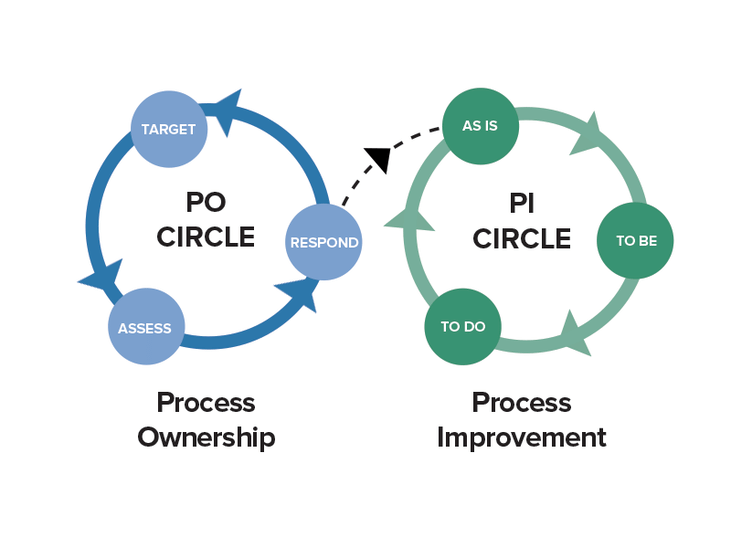
Most organizations fail to sustain effective process-based management because they fail to firmly embed business process governance.
Considerable effort goes into modeling many processes, process owners may be assigned, and some performance targets might even be agreed. Then nothing. None of this activity has any impact on the performance of the organization and at the first opportunity it is discontinued. “We tried BPM once and it didn't work”. Of course it didn't work – the M in BPM stands for management, not modeling, not meetings, not mucking about.
It doesn't have to be like that. BPM, more usefully described as process-based management, can have a powerful and positive effect on organization performance and the achievement of strategic objectives. One prerequisite is effective process governance.
Let's get serious. Considerable effort is required to model the process architecture, process owners (or whatever other title you choose) do need to be appointed, and process performance targets are important. Then it starts. The core process governance cycle is to measure the process performance gap, assess what, if anything, needs to be done now to adjust that gap, and then to take the required action. Then repeat, forever. In doing that, an organization has decided what is important, what process performance is required to enable the achievement of strategic objectives, and has embedded a system to monitor and control effective process performance.
The 'opportunity of governance' is to create and embed a systemic approach to determining process performance gaps and making evidence-based decisions about where the optimum return-on-effort will be achieved. When this is happening we can say that process-based management is working and that all of the process related activity is delivering a positive return-on-effort, a return that is reflected in demonstrable organization performance improvement and not just in a count of models developed or workshops completed.
Enabling Successful BPM
As some readers will know from my previous articles, I take a broad view of BPM seeing it as a management philosophy. A brief summary of that view is as follows.
Discovering, documenting, improving, and actively managing cross-functional business processes exposes opportunities for getting more and better work done with the same, or perhaps even fewer, resources. The power of process-based management is in understanding how work gets done, and based on that understanding, eliminating impediments, streamlining activities, and removing waste. The focus is on how the processes, including all of the people and resources involved, deliver value to the customers and other stakeholders. This cross-functional focus is missing in most organizations, where it is replaced with an internal management emphasis guided by the organization chart.
There are seven elements that come together to support process-based management:
- Discovery, understanding and documentation of the organization's processes in a hierarchical model – Process Architecture
- Defining process performance measures and measurement methods, collecting and reporting performance data –Process Measurement
- Responding to process measurement data by taking appropriate action to address actual or emergent performanceanomalies – Process Governance
- Continuously discovering processes that can perform better and finding ways to close the performance gaps –Process Change
- Creating an environment where the organization, its people, and teams are always conscious of the processes in which they participate – Process Mindset
- Developing tools and skills required throughout the organization to identify, analyze, improve, and manage business processes – Process Capability
- Providing support to develop, sustain and realize the benefits of process-based management – Process Support.
These seven enablers are shown in Figure 1. A Mobius strip is used to highlight the interdependencies between the elements.

The core artifact is the process architecture since documenting the key processes is the necessary first step. Once documented, processes performance measurements can be established and governance arrangements defined to show who should respond to performance reports. These first three enablers (architecture, measurement, governance) are the 'physical infrastructure' on which the rest is built. Continuous process change is the cornerstone of process-based management. Without process improvement, and its big brother process innovation, all else is waste. For process management and improvement to become ubiquitous, it must be embedded in the organization mindset. Having a central specialist group to do all process work, does not scale and it is necessary to build the capability for identifying, analyzing, improving, and managing business processes throughout the organization. Coherent support is required for all involved.
Defining BPM Governance
All seven of the enablers defined above are necessary for effective process-based management. They are all interdependent and a change in one will likely impact several others, a change in several will impact them all. Perhaps the most difficult enabler to achieve is governance. Process governance, done properly, requires a change in the way an organization is managed. It is intrusive, challenging, and confronting…and very powerful.
There are many ways to think about “BPM governance”. I am not talking about the narrow perspectives such as version control of process models, project management gateways to approve process changes, or release approvals for BPM software applications. I am talking about the ability of effective process-based management to continually discover opportunities for improvement and to consistently ensure that those improvements are achieved.
My view of process governance is shaped as two Virtuous Circles. I have written about this topic previously1 so just a brief summary here. The Tregear Circles are the PO circle (Process Ownership) and the PI circle (Process Improvement) as shown in Figure 2. Key activities in the PO circle are Target–Measure–Respond. In the PI circle the key elements are As Is – To Be – To Do.

The PO circle is continually and deliberately testing the performance of all processes to see if their actual or emergentperformance gaps or innovation opportunities require a response. Set a performance target for a process, measure what is really happening, and do something if the results are not what they should be, or if the target should be adjusted. This sequence of target–measure–respond ensures an unrelenting focus on the management of process and, therefore, organizational performance. Target-measure-respond is the 'drum beat' of BPM governance.
The PI circle is the process improvement cycle where we identify the current state, define the future state, and then make the required changes. Where real or potential process performance requires intervention, it is the PI circle that delivers process change. The PO circle determines if process adjustment is required in response to a current or emergent performanceanomaly, or a development opportunity; the PI circle discovers, details and delivers the business process change.
Conscious process management activity starts with the PO circle. At each iteration the PO circle can have one of three outcomes: (a) all is well and no action is required, (b) current performance is not meeting target and the PI circle is activated, or (c) the target is no longer valid and needs to be changed. The requirement is to be continually aware of performancegaps or opportunities and to challenge the status quo, making evidence-based decisions about which gaps, and in what order, need to be partially or completely closed. Effective ongoing process improvement requires a constant search for processes that can be improved. The real benefit of continuous improvement comes after the easy changes have been made – and this demands not just the PI circle to effect changes, but also the PO circle to continue to uncover the opportunities.
With these two circles consistently working well in a controlled way across the process architecture, an organization is working at the higher levels of BPM maturity. Creating the circumstance were the two circles are 'consistently working well' is not a trivial exercise – but once achieved, there is a mental and physical fly-wheel effect that is continually optimizing process performance; that is, continually assessing and adjusting the organization's cost-effective delivery of value to customers and other stakeholders.
How do we get the circles turning? We work on all of the 7 Enablers, but the focal point is to have effective Process Owners and related support mechanisms.
Process Ownership – the Linchpin of BPM
To create and sustain effective process-based management requires the appointment and support of active and engaged Process Owners.
The concept of process ownership is often misunderstood. A common implementation mode is to appoint people as Process Owners (or similar job title) and tell them they are responsible for the performance of their processes. This is almost certainly impossible. It is not reasonable to ask a Process Owner to be responsible for the performance of something, i.e. a cross-functional process, over which they have, at most, only partial control.
It is not the intention of process governance arrangements to change anything about organizational responsibilities. Appointing Process Owners makes no change to the organization chart and related responsibilities and authorities. The various business units that collaborate to execute a process are managed, as always, according to the organization chart. The Process Owner role liaises with those units in responding to process performance anomalies and opportunities.
The key aspect of process management is to have a plan for responding to process performance and to have people tasked to execute performance interventions. Process governance is mainly about responding in an appropriate way to actual or emergent process performance. Without such response, the measurement of process performance is meaningless. Remember that the organization chart is silent on the management of cross-functional processes.
Process Owners are accountable, not for the performance of the process, but for responding appropriately to processperformance reports.
While they may be involved because of other roles, a Process Owner has no operational involvement in the day-to-day management and execution of their process.
The Process Owner monitors process performance data and takes action when that performance is outside, or trending to be outside, of the target range, or when a change of target is appropriate. In doing so, the Process Owner is the advocate for the process, acting as a driving force for process performance optimization by being constantly aware of the gap between actual and target performance and making informed decisions about the extent to which such gaps need to be closed, and the timetable for doing so.
The ultimate outcome of effective process ownership and governance is proactive, efficient management, and continuous improvement, of the set of processes (and their subprocesses) by which an organization delivers value to its customers and other stakeholders.
In Practice…
There are many things you might do in response to the issues discussed in this Column. Here are five practical steps you might consider doing now to get started on the creation of sustainable process-based management.
- Define the business process architecture
Document the business process architecture to at least two levels to provide a hierarchical framework within which to create effective process governance. Use the exercise of developing the process architecture to increase interest in process management and to discern those who may be effective Process Owners. - Assign a Process Owner to one high-level process It may be easier and more productive to select one high level process and one enthusiastic Process Owner volunteer to start the process governance journey. Demonstrate the power of process governance in this cooperative environment before replicating that success in other processes.
- Get the Circles Turning Target-measure-respond. For the selected initial process(es) determine the process performancetargets, collect actual performance data, and have the Process Owners facilitate evidence-based decisions about what actions are necessary to address performance anomalies or opportunities.
- Review & Repeat Once the circles are consistently turning for the initial process(es) repeat the exercise for the remaining processes in at least the first two levels of the architecture.
- Track & Report At all times it is mandatory that the changes in organization performance that comes from process analysis, improvement, and management are documented and reported. If such changes cannot be demonstrated then it is reasonable to assume that all related activity has been a waste.
1 Tregear, R. Practical Process: 2 Virtuous Circles. http://www.bptrends.com/practical-process-2-virtuous-circles/. Accessed 29 December 2014.




